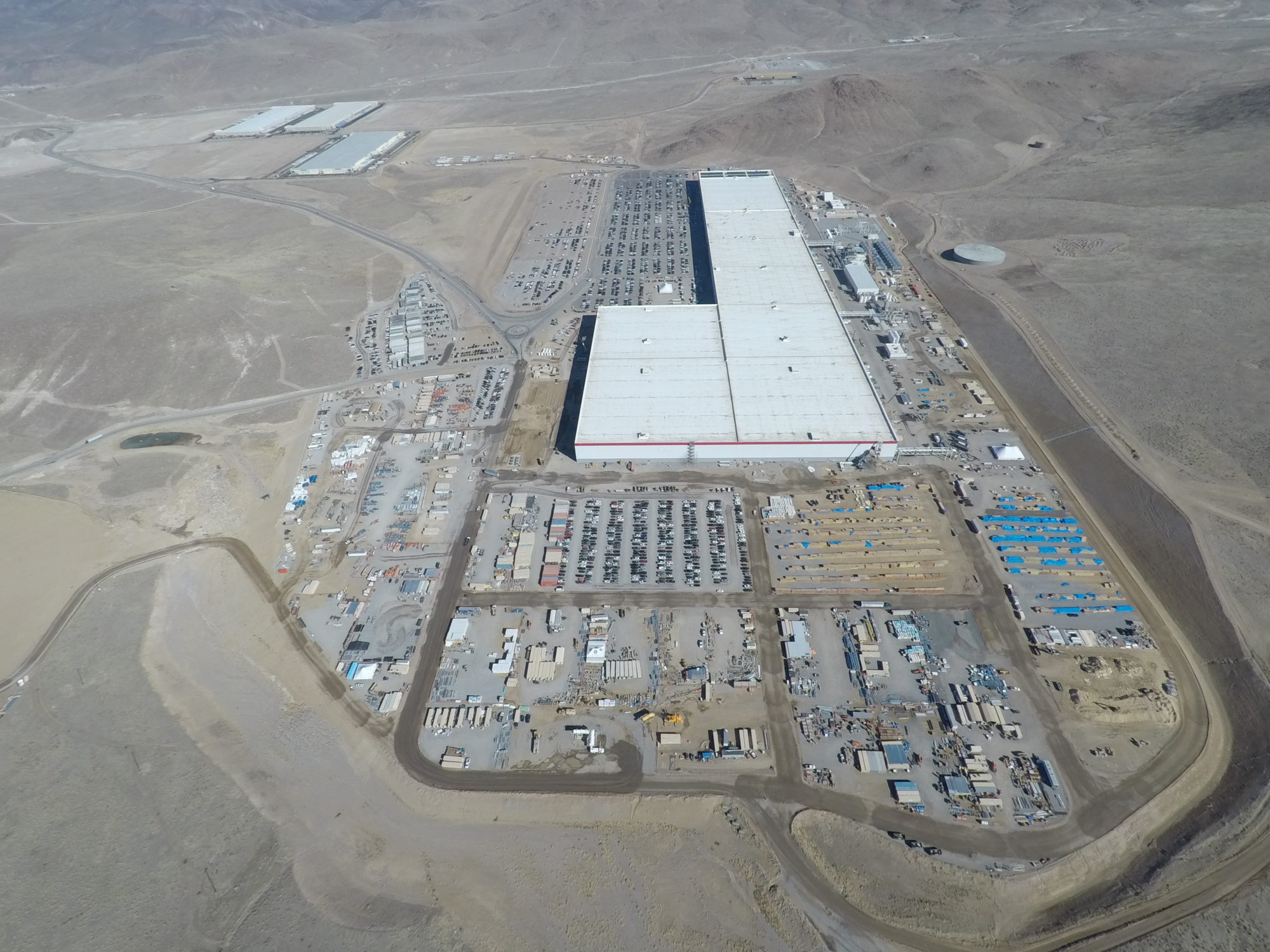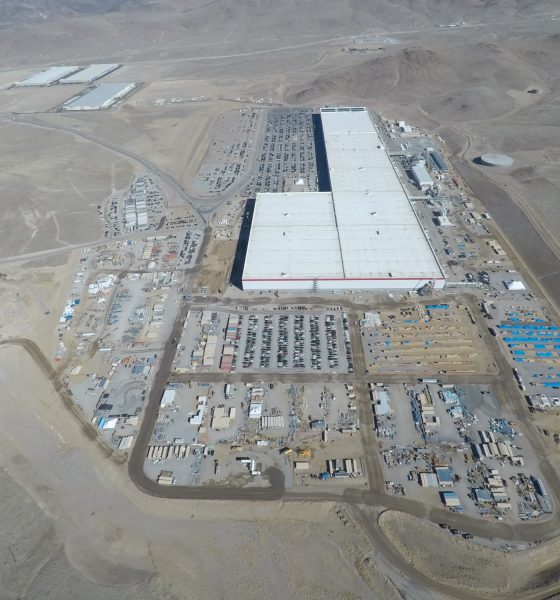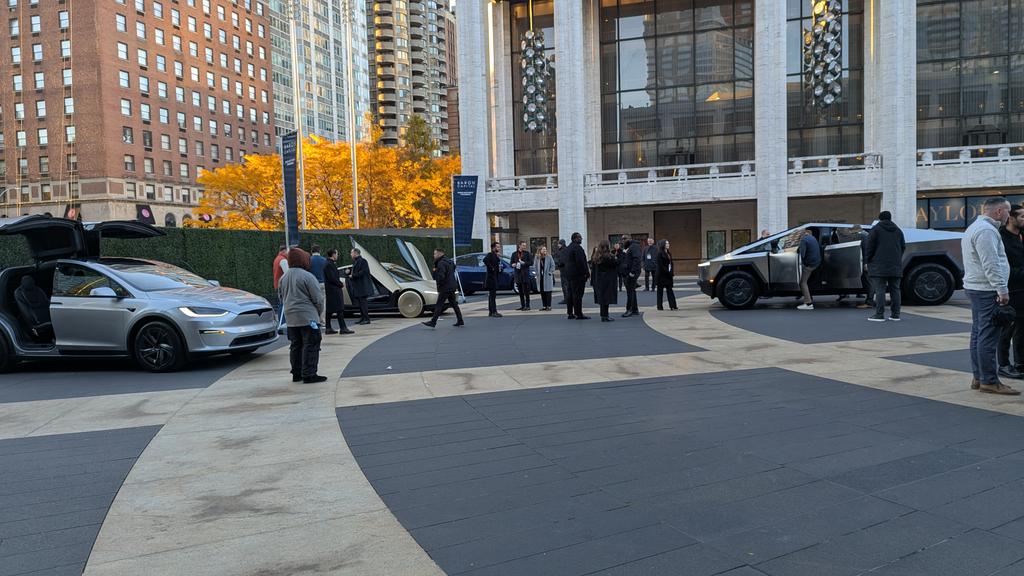

Investor's Corner
Tesla partner Panasonic to boost Gigafactory battery production capacity by 30% to address Model 3 ramp
Panasonic Corp, Tesla’s exclusive battery partner, is looking to increase its Gigafactory battery production capacity by 30% in order to address the increasing demands for battery cells due to the ongoing Model 3 ramp.
The update from Panasonic was published by 103-year-old Japanese news agency Nikkan Kogyo, which stated that the battery manufacturer would be adding three new cell production lines for lithium-ion batteries in Gigafactory 1 at the “end of 2018.” With the new lines in place, Panasonic would have a total of 13 lines producing cells for Tesla’s electric cars and battery storage systems. These improvements would allow Panasonic to meet the initially planned capacity of 35 GWh per year to supply Tesla’s production goal of consistently building 5,000 Model 3 per week — a goal that the electric car maker achieved during the end of Q2. Panasonic’s Gigafactory battery output is expected to increase by 30% with the addition of the new production lines.
The Model 3 ramp has taken a toll on Tesla, with the past year being riddled with production bottlenecks in both Gigafactory 1 and the Fremont factory. As of May, Tesla was reportedly producing less than 3,000 vehicles per week, while Panasonic’s production from its battery line proved sluggish as well. During Tesla’s burst production week in the final week of June, the company managed to build 5,000 Model 3 in seven days. To meet the Q2 goal, however, Panasonic reportedly had to use cells intended for Tesla’s household batteries to make more Model 3 battery packs.
With its battery production lines in Gigafactory 1 improved with more production capacity, Panasonic would be able to support the Model 3 ramp even as Tesla attempts to hit its target of producing 5,000-6,000 Model 3 per week for Q3. Tesla is ultimately aiming to run a sustained production rate of 10,000 Model 3 per week — a goal the company seeks to achieve by the middle of 2019, according to Tesla Senior Director of Investor Relations Aaron Chew in a meeting with investors and analysts earlier this month. To support such a level of Model 3 production, additional upgrades and expansions for Gigafactory 1 would likely be in the pipeline.
After the final week of Q2 2018, Panasonic noted that it would consider additional investment in Tesla’s Gigafactory 1 if needed. According to Yoshio Ito, the chief of Panasonic’s automotive business, the additional funding would be added to the ~$1.6 billion investment that the Japanese electronics giant already has in the Nevada-based battery factory.
Panasonic is the exclusive partner and battery cell supplier for Tesla’s electric cars and battery storage products, and as such, the Japanese company has been with the electric car maker since the beginning of the Model 3’s “production hell.” During the company’s shareholder meeting in late June, Panasonic noted that the accelerating pace of the Model 3’s production has started causing battery cell shortages.

Investor's Corner
Tesla wins $508 price target from Stifel as Robotaxi rollout gains speed
The firm cited meaningful progress in Tesla’s robotaxi roadmap, ongoing Full Self-Driving enhancements, and the company’s long-term growth initiatives.

Tesla received another round of bullish analyst updates this week, led by Stifel, raising its price target to $508 from $483 while reaffirming a “Buy” rating. The firm cited meaningful progress in Tesla’s robotaxi roadmap, ongoing Full Self-Driving enhancements, and the company’s long-term growth initiatives.
Robotaxi rollout, FSD updates, and new affordable cars
Stifel expects Tesla’s robotaxi fleet to expand into 8–10 major metropolitan areas by the end of 2025, including Austin, where early deployments without safety drivers are targeted before year-end. Additional markets under evaluation include Nevada, Florida, and Arizona, as noted in an Investing.com report. The firm also highlighted strong early performance for FSD Version 14, with upcoming releases adding new “reasoning capabilities” designed to improve complex decision-making using full 360-degree vision.
Tesla has also taken steps to offset the loss of U.S. EV tax credits by launching the Model Y Standard and Model 3 Standard at $39,990 and $36,990, Stifel noted. Both vehicles deliver more than 300 miles of range and are positioned to sustain demand despite shifting incentives. Stifel raised its EBITDA forecasts to $14.9 billion for 2025 and $19.5 billion for 2026, assigning partial valuation weightings to Tesla’s FSD, robotaxi, and Optimus initiatives.
TD Cowen also places an optimistic price target
TD Cowen reiterated its Buy rating with a $509 price target after a research tour of Giga Texas, citing production scale and operational execution as key strengths. The firm posted its optimistic price target following a recent Mobility Bus tour in Austin. The tour included a visit to Giga Texas, which offered fresh insights into the company’s operations and prospects.
Additional analyst movements include Truist Securities maintaining its Hold rating following shareholder approval of Elon Musk’s compensation plan, viewing the vote as reducing leadership uncertainty.
@teslarati Tesla Full Self-Driving yields for pedestrians while human drivers do not…the future is here! #tesla #teslafsd #fullselfdriving ♬ 2 Little 2 Late – Levi & Mario
Investor's Corner
Tesla receives major institutional boost with Nomura’s rising stake
The move makes Tesla Nomura’s 10th-largest holding at about 1% of its entire portfolio.

Tesla (NASDAQ:TSLA) has gained fresh institutional support, with Nomura Asset Management expanding its position in the automaker.
Nomura boosted its Tesla holdings by 4.2%, adding 47,674 shares and bringing its total position to more than 1.17 million shares valued at roughly $373.6 million. The move makes Tesla Nomura’s 10th-largest holding at about 1% of its entire portfolio.
Institutional investors and TSLA
Nomura’s filing was released alongside several other fund updates. Brighton Jones LLC boosted its holdings by 11.8%, as noted in a MarketBeat report, and Revolve Wealth Partners lifted its TSLA position by 21.2%. Bison Wealth increased its Tesla stake by 52.2%, AMG National Trust Bank increased its position in shares of Tesla by 11.8%, and FAS Wealth Partners increased its TSLA holdings by 22.1%. About 66% of all outstanding Tesla shares are now owned by institutional investors.
The buying comes shortly after Tesla reported better-than-expected quarterly earnings, posting $0.50 per share compared with the $0.48 consensus. Revenue reached $28.10 billion, topping Wall Street’s $24.98 billion estimate. Despite the earnings beat, Tesla continues to trade at a steep premium relative to peers, with a market cap hovering around $1.34 trillion and a price-to-earnings ratio near 270.
Recent insider sales
Some Tesla insiders have sold stock as of late. CFO Vaibhav Taneja sold 2,606 shares in early September for just over $918,000, reducing his personal stake by about 21%. Director James R. Murdoch executed a far larger sale, offloading 120,000 shares for roughly $42 million and trimming his holdings by nearly 15%. Over the past three months, Tesla insiders have collectively sold 202,606 shares valued at approximately $75.6 million, as per SEC disclosures.
Tesla is currently entering its next phase of growth, and if it is successful, it could very well become the world’s most valuable company as a result. The company has several high-profile projects expected to be rolled out in the coming years, including Optimus, the humanoid robot, and the Cybercab, an autonomous two-seater with the potential to change the face of roads across the globe.
@teslarati Tesla Full Self-Driving yields for pedestrians while human drivers do not…the future is here! #tesla #teslafsd #fullselfdriving ♬ 2 Little 2 Late – Levi & Mario
Investor's Corner
Ron Baron states Tesla and SpaceX are lifetime investments
Baron, one of Tesla’s longest-standing bulls, reiterated that his personal stake in the company remains fully intact even as volatility pressures the broader market.

Billionaire investor Ron Baron says he isn’t touching a single share of his personal Tesla holdings despite the recent selloff in the tech sector. Baron, one of Tesla’s longest-standing bulls, reiterated that his personal stake in the company remains fully intact even as volatility pressures the broader market.
Baron doubles down on Tesla
Speaking on CNBC’s Squawk Box, Baron stated that he is largely unfazed by the market downturn, describing his approach during the selloff as simply “looking” for opportunities. He emphasized that Tesla remains the centerpiece of his long-term strategy, recalling that although Baron Funds once sold 30% of its Tesla position due to client pressure, he personally refused to trim any of his personal holdings.
“We sold 30% for clients. I did not sell personally a single share,” he said. Baron’s exposure highlighted this stance, stating that roughly 40% of his personal net worth is invested in Tesla alone. The legendary investor stated that he has already made about $8 billion from Tesla from an investment of $400 million when he started, and believes that figure could rise fivefold over the next decade as the company scales its technology, manufacturing, and autonomy roadmap.
A lifelong investment
Baron’s commitment extends beyond Tesla. He stated that he also holds about 25% of his personal wealth in SpaceX and another 35% in Baron mutual funds, creating a highly concentrated portfolio built around Elon Musk–led companies. During the interview, Baron revisited a decades-old promise he made to his fund’s board when he sought approval to invest in publicly traded companies.
“I told the board, ‘If you let me invest a certain amount of money, then I will promise that I won’t sell any of my stock. I will be the last person out of the stock,’” he said. “I will not sell a single share of my shares until my clients sold 100% of their shares. … And I don’t expect to sell in my lifetime Tesla or SpaceX.”
Watch Ron Baron’s CNBC interview below.
@teslarati :rotating_light: This is why you need to use off-peak rates at Tesla Superchargers! #tesla #evcharging #fyp ♬ Blue Moon – Muspace Lofi








